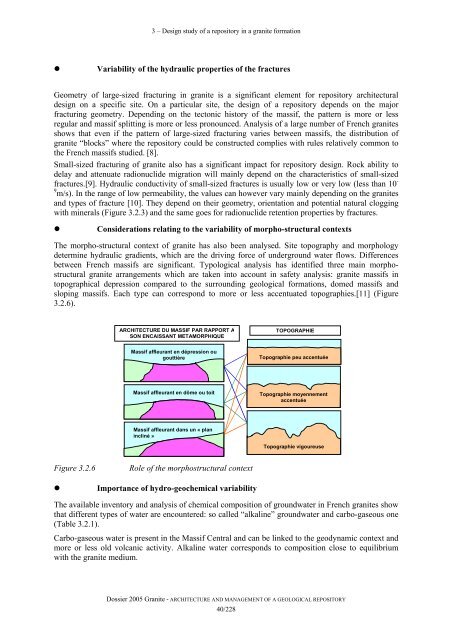3 – Design study <strong>of</strong> a <strong>repository</strong> in a granite formation• Variability <strong>of</strong> the hydraulic properties <strong>of</strong> the fracturesGeometry <strong>of</strong> large-sized fracturing in granite is a significant element for <strong>repository</strong> architecturaldesign on a specific site. On a particular site, the design <strong>of</strong> a <strong>repository</strong> depends on the majorfracturing geometry. Depending on the tectonic history <strong>of</strong> the massif, the pattern is more or lessregular <strong>and</strong> massif splitting is more or less pronounced. Analysis <strong>of</strong> a large number <strong>of</strong> French granitesshows that even if the pattern <strong>of</strong> large-sized fracturing varies between massifs, the distribution <strong>of</strong>granite “blocks” where the <strong>repository</strong> could be constructed complies with rules relatively common tothe French massifs studied. [8].Small-sized fracturing <strong>of</strong> granite also has a significant impact for <strong>repository</strong> design. Rock ability todelay <strong>and</strong> attenuate radionuclide migration will mainly depend on the characteristics <strong>of</strong> small-sizedfractures.[9]. Hydraulic conductivity <strong>of</strong> small-sized fractures is usually low or very low (less than 10 -9 m/s). In the range <strong>of</strong> low permeability, the values can however vary mainly depending on the granites<strong>and</strong> types <strong>of</strong> fracture [10]. They depend on their geometry, orientation <strong>and</strong> potential natural cloggingwith minerals (Figure 3.2.3) <strong>and</strong> the same goes for radionuclide retention properties by fractures.• Considerations relating to the variability <strong>of</strong> morpho-structural contextsThe morpho-structural context <strong>of</strong> granite has also been analysed. Site topography <strong>and</strong> morphologydetermine hydraulic gradients, which are the driving force <strong>of</strong> underground water flows. Differencesbetween French massifs are significant. Typological analysis has identified three main morphostructuralgranite arrangements which are taken into account in safety analysis: granite massifs intopographical depression compared to the surrounding <strong>geological</strong> formations, domed massifs <strong>and</strong>sloping massifs. Each type can correspond to more or less accentuated topographies.[11] (Figure3.2.6).ARCHITECTURE DU MASSIF PAR RAPPORT ASON ENCAISSANT METAMORPHIQUETOPOGRAPHIEMassif affleurant en dépression ougouttièreTopographie peu accentuéeMassif affleurant en dôme ou toitTopographie moyennementaccentuéeMassif affleurant dans un « planincliné »Topographie vigoureuseFigure 3.2.6Role <strong>of</strong> the morphostructural context• Importance <strong>of</strong> hydro-geochemical variabilityThe available inventory <strong>and</strong> analysis <strong>of</strong> chemical composition <strong>of</strong> groundwater in French granites showthat different types <strong>of</strong> water are encountered: so called “alkaline” groundwater <strong>and</strong> carbo-gaseous one(Table 3.2.1).Carbo-gaseous water is present in the Massif Central <strong>and</strong> can be linked to the geodynamic context <strong>and</strong>more or less old volcanic activity. Alkaline water corresponds to composition close to equilibriumwith the granite medium.Dossier 2005 Granite - ARCHITECTURE AND MANAGEMENT OF A GEOLOGICAL REPOSITORY40/228
3 – Design study <strong>of</strong> a <strong>repository</strong> in a granite formationTable 3.2.1in mg/l)Examples <strong>of</strong> groundwater chemical compositions in various French contexts (contentsType <strong>of</strong> water Sites pH Na K Ca Mg Li SiO2 Cl SO4 HCO3AlcalineSite 1 8,8 101,16 5,55 5,13 0,02 0,54 50,26 8,05 96,99 109,76Site 2 . 8,86 124,84 4,54 34,07 0,08 0,38 23,87 148,89 129,63 167,70Site 3 6,64 2195,54 170,46 62,92 47,15 9,85 47,73 3725,79 624,16 1798,93CarbogaseousSite 4 6,80 958,68 24,83 142,28 85,07 4,10 21,62 42,54 21,13 3482,02Site 5 6,67 899,91 94,62 605,18 391,31 5,34 58,97 2006,47 249,67 2451,44These differences in composition are not <strong>of</strong> a type to modify principles for the design optionsproposed. For certain granite massifs, they could lead to adjusting engineered barrier formulations tochemical composition <strong>of</strong> the water.• Considerations relating to the long-term <strong>geological</strong> evolution <strong>of</strong> French granite sitesIn terms <strong>of</strong> long-term <strong>geological</strong> evolution <strong>of</strong> a site, typological analysis <strong>of</strong> the granite massifs studiedconfirms that most <strong>of</strong> them are located away from active geodynamic areas, which means unlikelysignificant modifications in the long term to their <strong>geological</strong> arrangements, especially concerningunderground fracturing [12]. Climatic changes <strong>and</strong> erosion can also alter the hydro-<strong>geological</strong> <strong>and</strong>topographical context <strong>of</strong> a site in the long term. Variations exist between massifs mainly due todifferences in morpho-structural context. The analysis has thus identified the main arrangementsencountered within the French context <strong>and</strong> phenomena which could come into play within a timeframe<strong>of</strong> 10,000, 100,000 <strong>and</strong> 1,000,000 years. It should be pointed out that, on a scale <strong>of</strong> 100,000 years, themodels do not show any significant differences in evolution between the massifs. Beyond 100,000years, the situation <strong>of</strong> each massif is to be specifically taken into account for the study <strong>of</strong> a particularsite.3.3 General options for the design <strong>of</strong> a <strong>repository</strong> in a granite mediumIn order to fulfil long-term safety functions, the design proposed for a <strong>repository</strong> in granite mediumconsists <strong>of</strong>:- using a variety <strong>of</strong> technical arrangements to make the most <strong>of</strong> the beneficial properties <strong>of</strong> the granitemedium, its low permeability <strong>and</strong> mechanical resistance <strong>of</strong> granite rock in particular,- designing engineered <strong>repository</strong> components (disposal packages, engineered barriers, backfills, <strong>and</strong>seals) so that they contribute to safety functions in terms <strong>of</strong> complementarity or redundancy with thegranite medium.- adopting design options aiming at limiting granite disturbances by the <strong>repository</strong>.In addition to the long term <strong>and</strong> operational safety, design must meet reversibility requirement, closelylinked to application <strong>of</strong> the principle <strong>of</strong> precaution provided for in the 30 December 1991 Waste Act.Beyond the possibility <strong>of</strong> removing emplaced packages (retrievability), reversibility is based oncautious <strong>and</strong> staged <strong>management</strong> <strong>of</strong> a <strong>repository</strong>, which, given the timeframes under consideration,leaves the options open for future generations.These principles lead to adopting various technical arrangements for <strong>repository</strong> architecture <strong>and</strong>dimensioning, choice <strong>of</strong> materials for engineered components, <strong>and</strong> disposal processes. Somemeasures, architectural in particular, that are common to different categories <strong>of</strong> waste (B <strong>and</strong> C) <strong>and</strong> tospent fuel are presented below. Others, as for instance design <strong>of</strong> engineered components for example,that are specific to each waste categories are described in more detail in chapters 5, 6 <strong>and</strong> 7.Dossier 2005 Granite - ARCHITECTURE AND MANAGEMENT OF A GEOLOGICAL REPOSITORY41/228
















